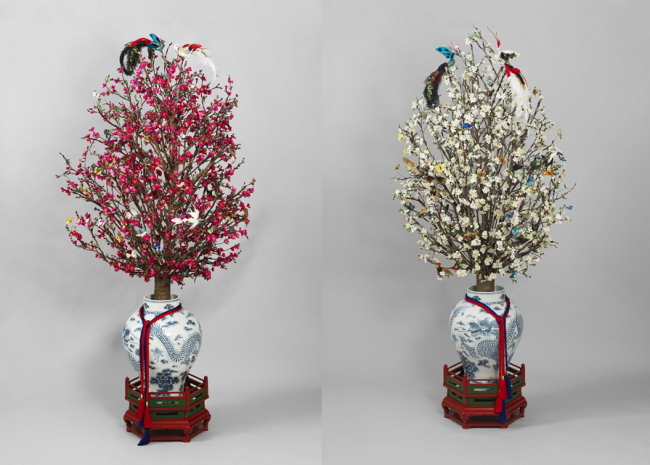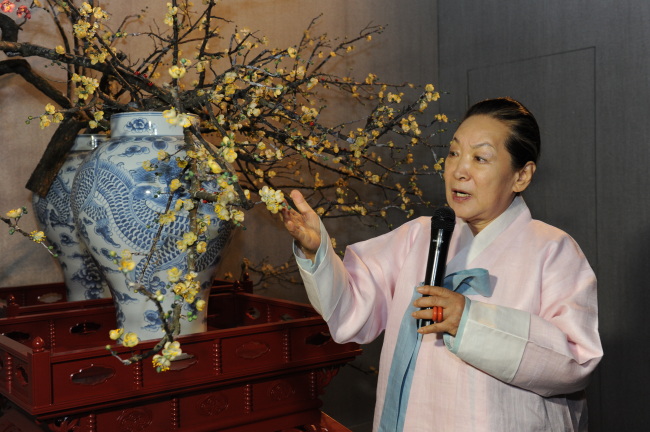A small exhibition, which opened Tuesday inside Gyeongbokgung Palace, brings back to life royal Joseon era (1392-1910) silk flowers, which look as delicate as real blossoms.
The “Beautiful Royal Silk Flowers” exhibition at the National Palace Museum of Korea displays works by silk flower master Hwang Su-ro and recreates two royal banquets held in 1829 to celebrate King Sunjo’s 40th birthday and the 30th anniversary of his enthronement.
The banquets, like any other function at the royal palace during the period, sported a splendid and elegant arrangement of artificial flowers made of silk, ramie, beeswax and other natural materials. These flowers were called chaehwa in Korean.
 |
Red and white peach tree blossoms, two of Hwang’s chaehwa works on display at the exhibition,were placed on the left and right sides of the king’s throne during royal ceremonies in the Joseonera. (Korea Cultural Heritage Administration) |
According to “Uigwe,” the book on royal ceremonies, a total of 11,846 of the flowers were used for the feasts: 5,289 for the daytime banquet hosted by the king and 6,557 for an evening one hosted by the queen.
“It took me nearly three years to recreate the chaehwa arrangements for the banquets in accordance with historical records,” Hwang said during a press preview Monday.
Chaehwa were not just for decoration. They were also an expression of royal majesty, she went on.
“The unwithering nature of chaehwa means the immortality of the dynasty.”
 |
Hwang Su-ro speaks during a press preview of the “Beautiful Royal SilkFlowers” exhibition at the National Palace Museum of Korea on Monday. (Korea Cultural Heritage Administration) |
The royal tradition of arranging exquisitely handcrafted blooms dates back more than a thousand years in Korea. However, chaehwa craftsmanship flourished during the Joseon era, particularly in the 18th and 19th centuries of its 600-year history. Many people of that period believed that plucking real flowers for one’s possession was not right.
For the last 200 years, however, it became something of a lost art, existing only in historical records.
Hwang devoted nearly 50 years of her life to reviving traditional chaehwa craftsmanship and for that she was designated last year Important Intangible Cultural Asset No. 124.
“Our ancestors developed such a fantastic handicraft to create exquisite and realistic flowers. So much so that at an outdoor exhibition in 2004, my chaehwa flowers (made in the traditional method) attracted bees and butterflies,” Hwang said.
The exhibition also offers a rare chance to compare Hwang’s works with similar artwork by French atelier house Legeron, one of the few silk flower-makers in the country.
“Hwang’s works are mostly for decoration, while mine focus more on fashion,” said Bruno Legaron, a fourth-generation member of the family who runs the atelier. It makes silk flowers and plumes for high fashion houses such as Dior, Givenchy, and Chanel.
“Still, there are surprisingly many similarities in the ways Hwang and I craft flowers and in the tools we use,” he said.
The exhibition runs through May 25 at the National Palace Museum located near exit 5 of Gyeongbokgung Station on Seoul Subway Line 3.
By Lee Sun-young (
milaya@heraldcorp.com)









